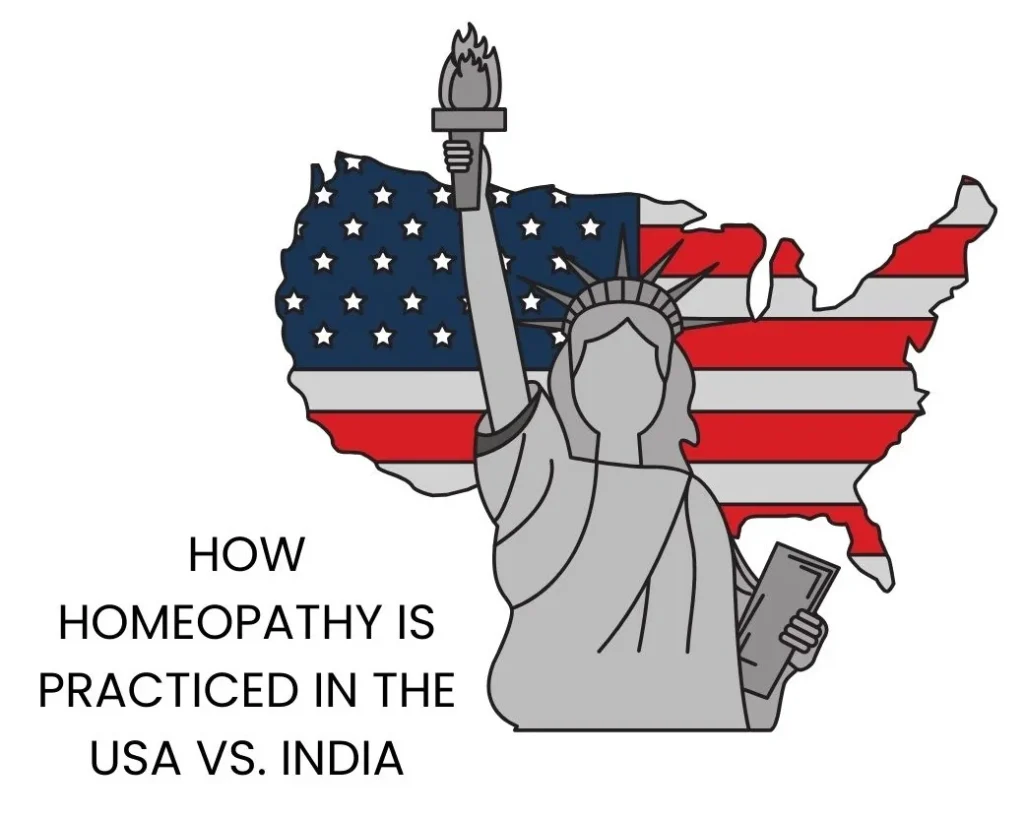Homeopathy is one of those systems of medicine that has sparked curiosity and debate around the world.
While it was born in Europe, its journey across continents has been very different in each country.
places where homeopathy has grown—albeit in contrasting ways—are India and the United States.
In this post, we’ll walk you through how homeopathy is practiced in both these countries: what’s similar, what’s different, and what that means for people seeking holistic healing.
WHY HOMEOPATHY IS GAINING POPULARITY WORLDWIDE
HOMEOPATHY IN DIFFERENT COUNTRIES A GLOBAL PERSPECTIVE ON HEALING

Table of Contents
Toggle🌍 A Tale of Two Countries
While India has embraced homeopathy as a mainstream part of its healthcare system, the USA treats it more as an alternative or complementary therapy.
That basic difference sets the tone for everything else—education, access, legal support, and even public perception.
In India: Homeopathy in the Heart of Tradition
- Government Support
In India, homeopathy is officially recognized and supported by the Ministry of AYUSH, alongside Ayurveda, Yoga, Unani, Siddha, and Naturopathy.
This gives it solid institutional backing and makes it a part of India’s national healthcare system.
- Education & Licensing
Becoming a homeopathic doctor in India is no joke. Students must complete a 5.5-year BHMS degree (Bachelor of Homeopathic Medicine and Surgery), which includes one year of internship.
Postgraduate studies (MD in Homeopathy) are also offered in many colleges.
Subjects include:
- Anatomy, Physiology, Pathology
- Bio-chemistry, Microbiology and Parasitology
- Materia Medica and Organon of Medicine
- Pharmacy and Homeopathic Repertory
- Forensic Medicine and Preventive Medicine
- Gynaecology and Surgery
- Practice of Medicine
- Research and Infrastructure
India has a strong research base for homeopathy through organizations like CCRH (Central Council for Research in Homeopathy).
Institutes like the National Institute of Homoeopathy (NIH) in Kolkata also contribute to both education and public healthcare.
- Wide Usage and Cultural Fit
From urban clinics to remote villages, homeopathy is everywhere in India.
People often prefer it for chronic diseases, children’s health, and emotional wellness.
It’s affordable, non-invasive, and widely trusted.
USA: Homeopathy as a Niche Wellness Choice
- Limited Legal Recognition
Homeopathy is available in the U.S., but it doesn’t enjoy the same level of institutional support as in India.
It is not part of the official medical system, and most homeopathic practitioners are considered alternative health providers, not licensed medical doctors.
- Education and Certification
There’s no government-regulated degree like BHMS in the U.S.
Homeopaths often train through private schools and certification programs.
Organizations like NASH (North American Society of Homeopaths) or CHC (Council for Homeopathic Certification) offer recognition, but it’s not mandatory.
- Regulations and Safety
The FDA (Food and Drug Administration) allows the sale of homeopathic remedies, but it is tightening regulations to ensure public safety.
There is no standard prescription practice, and anyone can technically call themselves a homeopath in many states.
- Popularity & Use
While homeopathy is not mainstream, it has a loyal following—especially among people who are into natural health, wellness, or holistic lifestyles.
Remedies are commonly found in health food stores and are often self-prescribed.
⚖️ Key Differences at a Glance
FEATURE | INDIA | USA |
Government Recognition | Fully integrated under Ministry of AYUSH | Not officially integrated into the mainstream system |
Education | BHMS degree (5.5 years), MD in Homeopathy | No standardized government-regulated degree |
Licensing | Regulated homeopathic practitioners | Varies by state; certification is optional |
Public Trust | High cultural acceptance, often first line of treatment | Niche audience, mostly alternative health enthusiasts |
Availability | Thousands of clinics, hospitals, and PHCs | Mostly private practice or health stores |
Research & Support | Strong institutional research (CCRH, NIH) | Limited, often privately funded studies |
❤️ What Makes Homeopathy Thrive in India?
- Deep-rooted belief in natural healing
- Institutional support from the government
- Affordability and accessibility
- Multi-generational usage and trust
🌱 Why It’s Still Growing in the USA
- Interest in integrative and holistic medicine
- Dissatisfaction with conventional medicine for chronic issues
- Easy access to over-the-counter remedies
- Wellness-driven culture and DIY healthcare trends
🤝 Can These Two Worlds Learn from Each Other?
Absolutely. The U.S. can learn from India’s structured approach to education and integration, while India can benefit from the USA’s emphasis on patient empowerment, innovation, and consumer safety.
Both systems highlight how homeopathy can coexist with other forms of medicine—whether it’s allopathy, Ayurveda, or naturopathy.
HOMEOPATHY VS. AYURVEDA VS. ALLOPATHY: KEY DIFFERENCES
✨ Final Thoughts
In India, homeopathy is a way of life. In the U.S., it is more like a lifestyle choice.
Both versions have their own strengths and weaknesses, but they reflect one universal truth:
People are looking for gentler, more personalized ways to heal.
Whether it’s a busy clinic in Kolkata or a wellness store in California, homeopathy continues to quietly work its magic—one remedy at a time.
